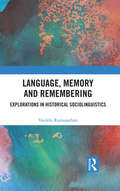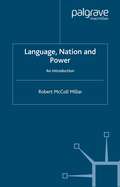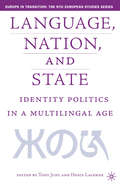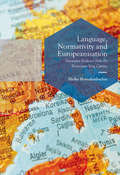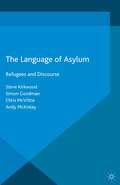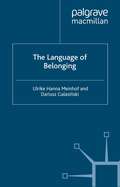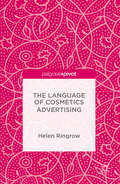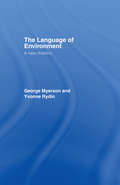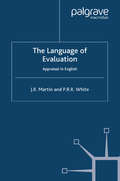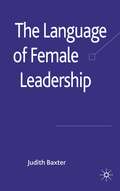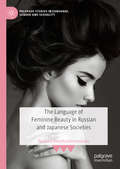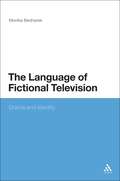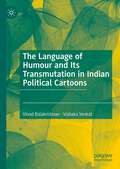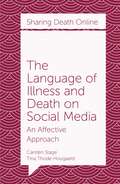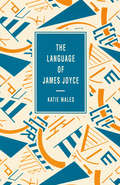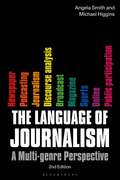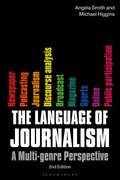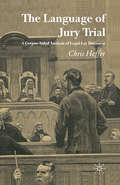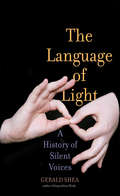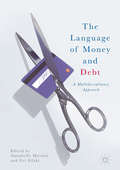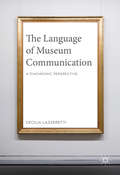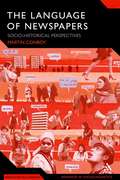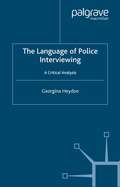- Table View
- List View
Language, Memory and Remembering: Explorations in Historical Sociolinguistics
by Vaidehi RamanathanThis volume explores issues of memory, remembering and language in late colonial India. It is the first systematic historical sociolinguistic study of English private and public citizens who lived in and/or worked for India and the Indian cause from the 1920s to the 1940s. While some of the English have lived as common citizens and were committed to India, their voices and contributions have remained on the margins of Indian collective memory. This book offers microhistorical readings of extended language forms generally underexplored in sociolinguistics (such as letters, telegrams, missives, and oral histories) to reorient facets of individual memories, lives, and endeavours against larger officialised understandings of the past. Using previously unpublished corpus of archival material and interviews with English private citizens from that period, this volume on historical sociolinguistics will be of interest to scholars and researchers of language and linguistics, South Asian studies, post-colonial literary studies, culture studies, and modern history.
Language, Nation and Power: An Introduction
by R. MillarLanguage, Nation and Power provides students with a discussion of the ways in which language has been (and is being) used to construct national (or ethnic) identity. It focuses on the processes by which a language can be planned and standardized and what the results of these processes are. Particular emphasis is given to the historical and social effects which nationalism has had on the development of language since the French Revolution. For students of linguistics, sociology and politics.
Language, Nation and State: Identity Politics in a Multilingual Age (Europe in Transition: The NYU European Studies Series)
by T. Judt D. LacorneThis edited collection examines the role that language has played in forming modern European nations. With language an omnipresent issue within the European Union, the importance languages have played within the histories and present situations of member nations is a crucial topic. Drawing on an international cast of contributors, the book explores the issues of monolingualism vs. plurilingualism within individual nations, the revival of languages in nations such as former soviet republics, and concludes with a look at language in the electronic age.
Language, Normativity and Europeanisation: Discursive Evidence from the Eurovision Song Contest (Postdisciplinary Studies in Discourse)
by Heiko MotschenbacherThis book focuses on linguistic practices of identity construction in a popular culture media context, the Eurovision Song Contest. Subscribing to a normativity-based approach to critical discourse analysis, it studies Europeanisation as it surfaces at the discursive interface of European, national and sexual identities in Eurovision lyrics and performances. Research in critical discourse analysis that deals with Europeanisation, or the discursive work involved in European identity formation, has so far mainly studied data from EU political contexts that illustrate a top-down approach to what Europeanness means. The present book complements this earlier research in several ways, focusing on the linguistic construction of identities, and its interrelation with non-linguistic modes of signification in the Eurovision Song Contest. Discursive mechanisms that prove to be central for the normative shifts of Europeanisation in the given context are de-essentialisation, inclusion, camp, crossing and languaging.
The Language of Asylum: Refugees and Discourse
by Simon Goodman Chris McVittie Andy McKinlay Steven KirkwoodThe early part of the 21st century has been marked by widespread social upheaval and geographical displacement of people. This book examines how refugees, asylum-seekers, locals and professional refugee workers make sense of asylum and refuge in the context of current UK asylum policies.
The Language of Belonging (Language and Globalization)
by U. Meinhof D. GalasinskiThis examines a significant aspect of contemporary social life: cultural identities and our linguistic means of constructing them. It combines a theoretical re-assessment of processes of identification with case studies of the discourses of three-generation families living in split-border communities along the former 'Iron Curtain'.
The Language of Cosmetics Advertising
by Helen RingrowThis book offers a cross-cultural comparison of French and British cosmetics advertisements and explores how the discourse of beauty advertising represents ideas about femininity in French and English language contexts. As the global beauty industry expands and consumers become more critical of the claims made, the topic of cosmetics advertising discourse is examined using Feminist Critical Discourse Analysis. One common theme underlying most cosmetics advertising discourse is that the female body always requires ‘work’ to fix its ‘problems’: flat skin, dry hair, and so on. The author uses themes of language and gender, media and identity, and advertising across cultures to expose exactly what is going on in the language of cosmetics advertising and to offer a first step towards challenging these ideas and thinking about alternatives.
The Language Of Environment: A New Rhetoric
by George Myerson Yvonne RydinFirst published in 1996. Routledge is an imprint of Taylor & Francis, an informa company.
The Language Of Environment: A New Rhetoric
by George Myerson Yvonne RydinFirst published in 1996. Routledge is an imprint of Taylor & Francis, an informa company.
The Language of Evaluation: Appraisal in English
by J. Martin Peter R.R. WhiteThis is the first comprehensive account of the Appraisal Framework. The underlying linguistic theory is explained and justified, and the application of this flexible tool, which has been applied to a wide variety of text and discourse analysis issues, is demonstrated throughout by sample text analyses from a range of registers, genres and fields.
The Language of Female Leadership
by J. BaxterCould language be a reason why women are under-represented at senior level in the business world? Using data from senior management meetings, this book explores how female leaders use language to achieve their business and relational goals by arguing that senior women have to develop linguistic expertise in order to be effective leaders.
The Language of Feminine Beauty in Russian and Japanese Societies (Palgrave Studies in Language, Gender and Sexuality)
by Natalia KonstantinovskaiaThis book conducts a cross-linguistic and cross-cultural study of 'women’s language' as it pertains to feminine beauty. It examines the ideological constructs of beauty and femininity in the cultures of Japan and Russia, as embodied through televised beauty ads, and relates them to the real-world language practices of Japanese and Russian women. The author traces the reciprocal connection between women’s real and imagined language in the construction of ideals of beauty and femininity, revealing the complex ways women respond to ideological expectations regarding language use: assimilating, transforming, and subverting ideologized language and the assumptions implicit in it. She also demonstrates ways in which women alter the texture of language by appropriating 'masculine' language for their own purposes, shifting the meaning and correlates of linguistic items and structures. This book will be of interest to students and scholars of sociolinguistics, language and gender, cultural and media studies, and Russian and Japanese culture.
The Language of Fictional Television: Drama and Identity
by Monika BednarekWith cases studies used throughout to help illustrate the more general points, this is an analysis of the most important characteristics of television dialogue, with a focus on fictional television. The book illustrates how we can fruitfully and systematically analyse the language of television.
The Language of Humour and Its Transmutation in Indian Political Cartoons
by Vinod Balakrishnan Vishaka VenkatThis book develops a model to examine the language of humour, which is multimodal and accounts for the possibility of transmutation of humour as it is performed through editorial cartoons. By transmutation is meant the transition in the language of humour when it crosses its own boundaries to provoke unprecedented reactions resulting in offensiveness, disappointment or hurt sentiment. The transmutability about the language of humour points to its inherently diabolical nature which manifests in the performance of controversial cartoons. The model is built by borrowing theoretical cues from Roman Jakobson, Roland Barthes, George Lakoff and Mark Johnson. The integrated model, then, is developed to examine the cartoons which were recommended for deletion by the Thorat Committee, following a cartoon controversy in India. Through the cartoon analysis, the model discerns the significance of context and temporality in determining the impact of humour. It also examines how the ethics of humour; the blurred lines of political correctness and incorrectness are dictated by the political atmosphere and the power dynamics.
The Language of Illness and Death on Social Media: An Affective Approach (Sharing Death Online)
by Carsten Stage Tina Thode HougaardThis book investigates the language created and used on social media to express and respond to personal experiences of illness, dying and mourning. The authors begin by setting out the established and recent research on social and existential media, affect and language, before focusing on Facebook groups dealing with the illness and death of two Danish children. Through these in-depth case studies, they produce insights into different ways of engaging in affective processes related to illness and death on social media, and into both the ritualized and innovative vernacular vocabulary created through these encounters. Developing an analytical framework for understanding the social role and logics of "affective language" (such as emojis, interjections and other forms of expressive interactive writing), The Language of Illness and Death on Social Media will be of great interest to all those striving to understand the affective importance and roles of language for sharing experiences of illness, death and commemoration in these spheres.
The Language of James Joyce (The Language of Literature)
by Katie Wales Geoff ScottThis book presents the first sustained analysis for students of the language and style of Joyce's major prose works in the light of current work in language studies, stylistics and literary theory. Each chapter addresses a particular aspect of the style of a prose work or text, rhetoric (Dubliners, and A Portrait of the Artist as a Young Man), speech and thought presentation and word-play (Ulysses) and sound-play (Finnegans Wake). The book is written specifically for undergraduates and general readers interested in Joyce who may lack a linguistic background.
The Language of Journalism: A Multi-Genre Perspective
by Angela Smith Michael HigginsThe Language of Journalism (2nd edition) provides lively and accessible tools to understand and analyse the language of journalism. The authors explain how language develops across divergent media platforms, old and new, by looking at the differences across various forms of journalism – including broadcast, magazine, newspaper, sports, radio, and online and citizen. As well as introducing the reader to the principles and methods of discourse analysis and how it can be applied to media, the book addresses the dynamic interplay between the emerging linguistic forms of social media and the journalistic field.With this new edition, the authors draw upon a range of international examples, including from the USA, India, Australia, China and the UK. They focus on an exploration of how social media is incorporated into the journalistic output of print media, with a particular focus on 'clickbait'. This edition also focuses on the global ambitions of online newspapers – such as the Daily Mail and the Guardian – which are UK based, but have Australian and US subsections.
The Language of Journalism: A Multi-Genre Perspective
by Angela Smith Michael HigginsThe Language of Journalism (2nd edition) provides lively and accessible tools to understand and analyse the language of journalism. The authors explain how language develops across divergent media platforms, old and new, by looking at the differences across various forms of journalism – including broadcast, magazine, newspaper, sports, radio, and online and citizen. As well as introducing the reader to the principles and methods of discourse analysis and how it can be applied to media, the book addresses the dynamic interplay between the emerging linguistic forms of social media and the journalistic field.With this new edition, the authors draw upon a range of international examples, including from the USA, India, Australia, China and the UK. They focus on an exploration of how social media is incorporated into the journalistic output of print media, with a particular focus on 'clickbait'. This edition also focuses on the global ambitions of online newspapers – such as the Daily Mail and the Guardian – which are UK based, but have Australian and US subsections.
The Language of Jury Trial: A Corpus-Aided Analysis of Legal-Lay Discourse
by C. HefferDrawing on representative corpora of transcripts from over 100 English criminal jury trials, this stimulating new book explores the nature of 'legal-lay discourse', or the language used by legal professionals before lay juries. Careful analyses of genres such as witness examination and the judge's summing-up reveal a strategic tension between a desire to persuade the jury and the need to conform to legal constraints. The book also suggests ways of managing this tension linguistically to help, not hinder, the jury.
The Language of Light: A History of Silent Voices
by Gerald SheaA comprehensive history of deafness, signed languages, and the unresolved struggles of the Deaf to be taught in their unspoken tongue Partially deaf due to a childhood illness, Gerald Shea is no stranger to the search for communicative grace and clarity. In this eloquent and thoroughly researched book, he uncovers the centuries-long struggle of the Deaf to be taught in sign language—the only language that renders them complete, fully communicative human beings. Shea explores the history of the deeply biased attitudes toward the Deaf in Europe and America, which illogically forced them to be taught in a language they could neither hear nor speak. As even A.G. Bell, a fervent oralist, admitted, sign language is "the quickest method of reaching the mind of a deaf child." Shea’s research exposes a persistent but misguided determination among hearing educators to teach the Deaf orally, making the very faculty they lacked the principal instrument of their instruction. To forbid their education in sign language—the “language of light”—is to deny the Deaf their human rights, he concludes.
The Language of Money and Debt: A Multidisciplinary Approach
by Annabelle Mooney Evi SifakiThis book analyses the language that ordinary people employ when discussing money, debt and financial behaviour. It documents and critiques this language from an array of disciplinary perspectives, with chapters on children’s books, government infomercials, television poverty porn, the emotional experience of being indebted, and more. In doing so, it addresses common underlying questions concerning definitions of money and value, and scrutinises how people construct, negotiate and articulate meaning in these domains. This wide-ranging edited collection will be of interest to students and scholars of linguistics, sociology, communication, literature and anthropology.
The Language of Money and Debt: A Multidisciplinary Approach
by Annabelle Mooney Evi SifakiThis book analyses the language that ordinary people employ when discussing money, debt and financial behaviour. It documents and critiques this language from an array of disciplinary perspectives, with chapters on children’s books, government infomercials, television poverty porn, the emotional experience of being indebted, and more. In doing so, it addresses common underlying questions concerning definitions of money and value, and scrutinises how people construct, negotiate and articulate meaning in these domains. This wide-ranging edited collection will be of interest to students and scholars of linguistics, sociology, communication, literature and anthropology.
The Language of Museum Communication: A Diachronic Perspective
by Cecilia LazzerettiThis volume explores the evolution of the language of museum communication from 1950 to the present day, focusing on its most salient tool, the press release. The analysis is based on a corpus of press releases issued by eight high-profile British and American museums, and has been carried out adopting corpus linguistics and genre analysis methodologies. After identifying the typical features of the museum press release, new media more recently adopted by museums, such as web presentations, blogs, e-news, and social media, are taken into consideration, exploring questions such as how has the language of museum communication changed in order to face the challenge posed by new technologies? Are museum press releases threatened by new approaches used in contemporary public relations? Are the typical press release features still detectable in new genres? Drawing on insights from linguistics, discourse analysis, and museum communication this book will be of great value to researchers and practitioners of applied linguistics, sociolinguistics, and museum communication scholars.
The Language of Newspapers: Socio-Historical Perspectives (Advances in Sociolinguistics)
by Martin ConboyThis book charts the connections between the language of journalism in England and its social impact on audiences and social and political debates from the first emergence of periodical publications in the seventeeth century to the present day. It extends work done on the language of the media to include an historical perspective, adding to wider contemporary debates about the social impact of the media. It draws upon the field of historical pragmatics, while retaining a concentration on the development of a particular form of media language, the newspaper, and its role in refracting and contributing to social developments. Dialogue is created between sociolinguistics and journalism studies. It is ideally suited to advanced students in these areas and in linguistics and media studies in general.
The Language of Police Interviewing: A Critical Analysis
by G. HeydonPolice interviewing is a critical part of the justice process, and more attention is now being paid to training in interview techniques. This new study uses tools drawn from interactional sociolinguistics and conversation analysis for a detailed study of some police questioning of adult suspects, and work undertaken in the training of police in interviewing children - in which quite different approaches seem to be adopted. Critical discourse analytic techniques are used in interpreting the outcome and the implications for training are explored.
